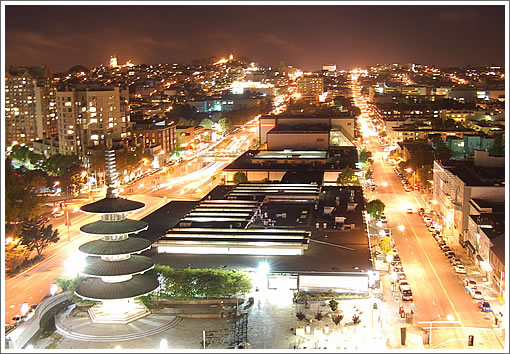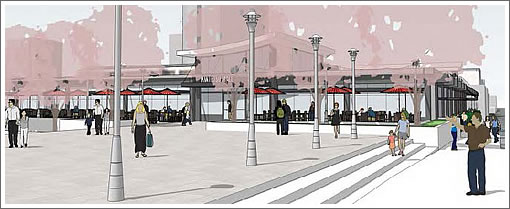
The strategy for saving San Francisco’s Japantown, seeking to secure Japantown’s future as the historical and cultural heart of the Japanese community and as a physically attractive, vibrant and thriving commercial district has been finalized.
The Japantown Cultural Heritage and Economic Sustainability Strategy (JCHESS) includes the creation of a Community Development Corporation, a Community Benefits District, a Neighborhood Commercial District, and making improvements to Peace Plaza and the Buchanan Mall.

The plan will be presented to San Francisco’s Planning Commission tomorrow with the public hearings needed for the JCHESS to become City policy anticipated to be held in September.
Opening it to the street on all sides (especially Geary) is probably the greatest improvement for the lowest cost. Even with bigger anchor tenants, if they could get trendy Asian chains like Uniqlo or Muji, that would be great. Unfortunately the location away from rail hurts the mall’s standing among international retailers, who want to serve the whole Bay Area. Japantown/Fillmore is a local spot.
Agree Muji would have been a great addition here, so wierd they chose outer SOMA location near a freeway offramp. The mall is so badly outdated (plastic flowers?) it’s almost become kitschy.
The problem with J-Town is it’s proximity to the Western Addition projects. That neighborhood would be a gem if not for the slum across the street.
Remodeling will not change this.
Now lets just get MUNI to extend the California street cable car and have it terminate next to the plaza! I know MUNI has been thinking about extending the cable car line to Japan Town for sometime, unfortunately they haven’t been able to get the funding to do so.
“Presenting The Strategy For Saving San Francisco’s Japantown.”
Talk about a lie… Japantown is thriving, even though no one can afford to use the garage any more since the jerks at the SFMTA jacked up the pricing so much.
But as someone who has been enjoying Japantown for over 30 years, its never been more hopping.
SF has done enough to treat its Japanese residents like crap over the decades. Why trash talk Japantown now?
I dont believe extended the california cable car is a good idea. For thoses interested in getting to japantown, the muni 1 is very frequent and only a 4 block walk
Japantown has already improved, and it is much busier than it used to be. There are many good restaurants, with a range of prices, some very modest, and a few dessert places. There are young and old people, from many neighborhoods including those to the north. Fillmore comes downhill and joins at the corner of Post.
It is a terrific part of SF. I hope this does not ruin it.
I am assuming that Muji made that little dinky store on Ninth simply to test the market. They would be great in Japantown, but also great in the new Market Street Place at 6th and Market. The Japanese locations have something like 50,000+ items, so there is definitely plenty of merchandise that Americans have yet to see out of Muji.
Live a few blocks away, although on the south side so I’m in the horrible slum. Point of fact, there are no projects across the street from Japantown.
Neighborhood has improved in the five plus years I’ve been there. Its slow progress but its progress. A few new (or last couple years new) places are opening up on the south side of Geary that seem to be drawing more people further south down Fillmore. The Sundance Kabuki is a great draw for the area with its assigned seating, which makes it easier for people to preorder tickets and then hit one of the local restaurants for dinner and movie.
You want to revive Japantown? Add more residential, dense housing. High-rises along Geary with bottom-floor retail. Do the same on the project side and gradually start getting rid of the Western Addition project. Prime-land for residential building and productive citizens.
Underated part of town. It’s fun to go there during the SF Film Festival. Reminds me what SF was like 10 years ago…
@egg_cream, what they’re talking about saving is not Japantown, the neighborhood, but Japantown, the idea. It’s obvious at a glance that hardly any Japanese live in Japantown anymore (the Planning doc says they’re 5% of residents), and those who do are mostly old. The original Japanese ghetto was built out of necessity, in a time when yellow people weren’t welcome in white neighborhoods. Now that Japanese people can live anywhere, they do.
In some sense it’s the same with the culture. The Japan Center malls are not almost kitschy, they’re beyond kitschy — a 1980’s version of an American’s idea of Olde Japan, back before Japan became synonymous with high-quality cars and cutting-edge fashion. Japanese influence in America is ubiquitous now, from video games to Zen-inspired mindful parenting. We don’t need to go to JTown to experience Japanese culture.
As a half-Japanese American, I’d be happy to forget the nostalgic preservationism — trying to preserve a neighborhood that’s been a memory for longer than it existed — and just implement some of the motherhood-and-apple-pie good urban design recommendations in the report. And I just wish it was easier to get to Nijiya for when I want to cook some sukiyaki or okonomiyaki.
@Kenz,
I agree that the mall, etc of Japantown is kitschy but at the same time it reminds me of many of the same rundown malls throughout Japan that are one step from the bulldozer. I really wouldn’t consider it to be a representation of “olde Japan” as much as I would think of it more as post-war Japan before redevelopment.
Japantown is not kitsch. It is a little scruffy and dated, but not unpleasant. It is unpretentious in a pretentious town. I hope they do not ruin it, and I hope they do not price out the modest shops and restaurants. We do not need a Japanesque version of Union or Chestnut.
^I think you’re not quite understanding what the word “kitsch” means. Japantown in its current incarnation is practically the definition of kitsch. That may or may not be a bad thing, but it has nothing to do with being “unpleasant” or “unpretentious” or “pretentious”.
I understand exactly what the word kitsch means.
Japantown is not kitsch. It is not pretentious and not in bad taste and not lowbrow.
You might want to check the real definition before questioning the use of words by others.
The problem with this place ( ironically ) is the feng shui.
What does kitsch have to do with being pretentious?
So we can at least agree that the important question here is, what would Clement Greenberg think about Japantown?